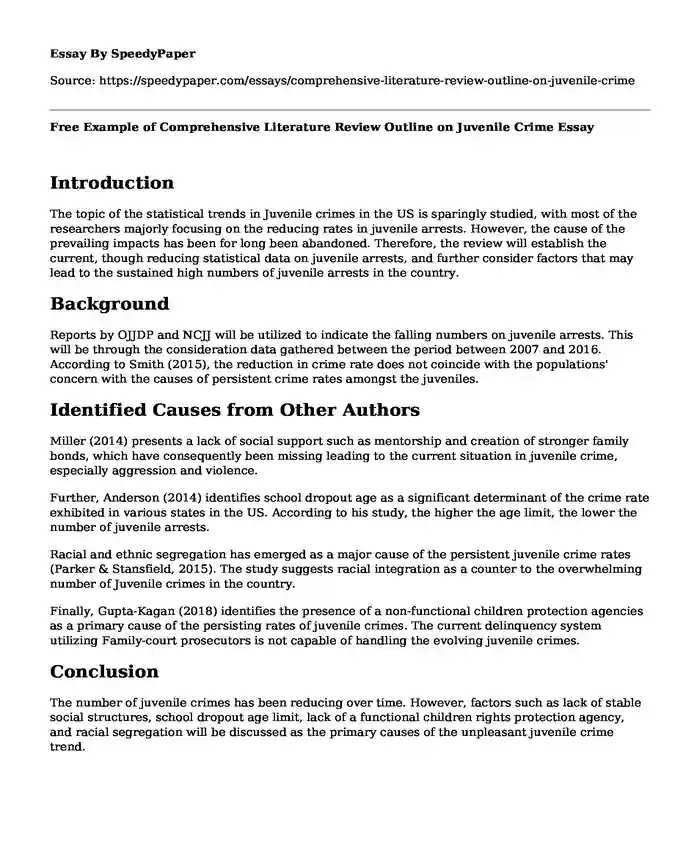
| Type of paper: | Creative writing |
| Categories: | Juvenile justice |
| Pages: | 2 |
| Wordcount: | 453 words |
Introduction
The topic of the statistical trends in Juvenile crimes in the US is sparingly studied, with most of the researchers majorly focusing on the reducing rates in juvenile arrests. However, the cause of the prevailing impacts has been for long been abandoned. Therefore, the review will establish the current, though reducing statistical data on juvenile arrests, and further consider factors that may lead to the sustained high numbers of juvenile arrests in the country.
Background
Reports by OJJDP and NCJJ will be utilized to indicate the falling numbers on juvenile arrests. This will be through the consideration data gathered between the period between 2007 and 2016. According to Smith (2015), the reduction in crime rate does not coincide with the populations' concern with the causes of persistent crime rates amongst the juveniles.
Identified Causes from Other Authors
Miller (2014) presents a lack of social support such as mentorship and creation of stronger family bonds, which have consequently been missing leading to the current situation in juvenile crime, especially aggression and violence.
Further, Anderson (2014) identifies school dropout age as a significant determinant of the crime rate exhibited in various states in the US. According to his study, the higher the age limit, the lower the number of juvenile arrests.
Racial and ethnic segregation has emerged as a major cause of the persistent juvenile crime rates (Parker & Stansfield, 2015). The study suggests racial integration as a counter to the overwhelming number of Juvenile crimes in the country.
Finally, Gupta-Kagan (2018) identifies the presence of a non-functional children protection agencies as a primary cause of the persisting rates of juvenile crimes. The current delinquency system utilizing Family-court prosecutors is not capable of handling the evolving juvenile crimes.
Conclusion
The number of juvenile crimes has been reducing over time. However, factors such as lack of stable social structures, school dropout age limit, lack of a functional children rights protection agency, and racial segregation will be discussed as the primary causes of the unpleasant juvenile crime trend.
References
Anderson, D. (2014). In School and Out of Trouble? The Minimum Dropout Age and Juvenile Crime. Review of Economics And Statistics, 96(2), 318-331. doi: 10.1162/rest_a_00360'
Miller, L. (2014). Juvenile crime and juvenile justice: Patterns, models, and implications for clinical and legal practice. Aggression and Violent Behavior, 19(2), 122-137. doi: 10.1016/j.avb.2014.01.005.
OJJDP. (2018). Estimated number of juvenile arrests, 2016. Retrieved from https://www.ojjdp.gov/ojstatbb/crime/qa05101.asp.
Parker, K., & Stansfield, R. (2015). The Changing Urban Landscape: Interconnections Between Racial/Ethnic Segregation and Exposure in the Study of Race-Specific Violence Over Time. American Journal Of Public Health, 105(9), 1796-1805. doi: 10.2105/ajph.2015.302639.
Anderson, D. (2014). In School and Out of Trouble? The Minimum Dropout Age and Juvenile Crime. Review of Economics And Statistics, 96(2), 318-331. doi: 10.1162/rest_a_00360'
Cite this page
Free Example of Comprehensive Literature Review Outline on Juvenile Crime. (2022, Jun 27). Retrieved from https://speedypaper.net/essays/comprehensive-literature-review-outline-on-juvenile-crime
Request Removal
If you are the original author of this essay and no longer wish to have it published on the SpeedyPaper website, please click below to request its removal:
- Organizational Culture Essay Sample
- Free Essay on Working Alone or in Group of People
- The Diary of Anne Frank, 1959 - Movie Analysis Essay Sample
- Essay Sample on How Important is Similarity in Friendship?
- Art Essay Sample Dedicated to Basquiat
- The Influence of Society - Literary Essay Example
- Employee Satisfaction: Finding a Balance for Maximum Performance
Popular categories




